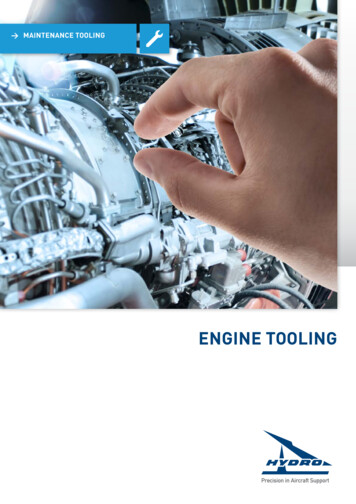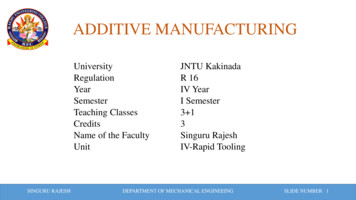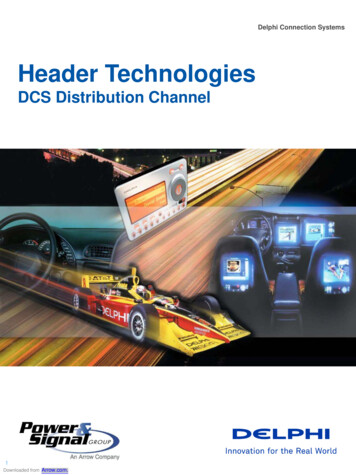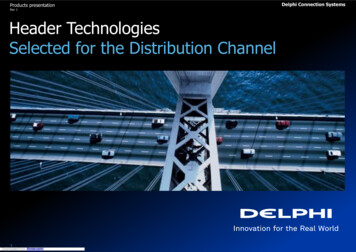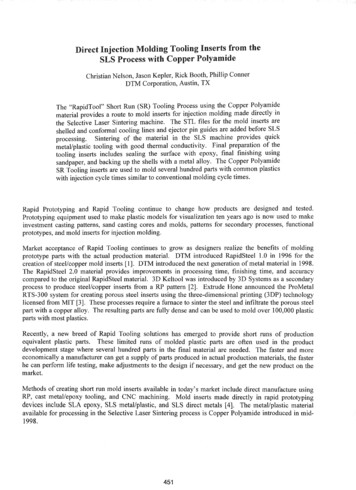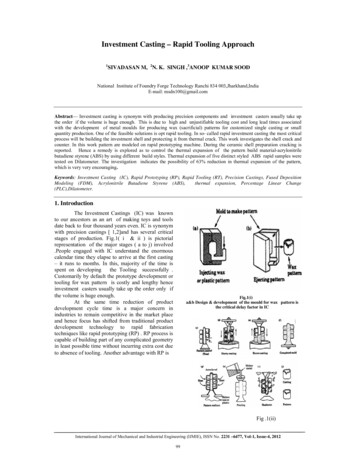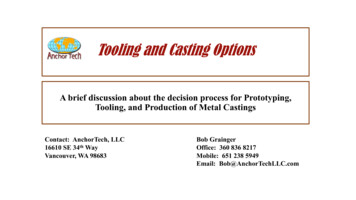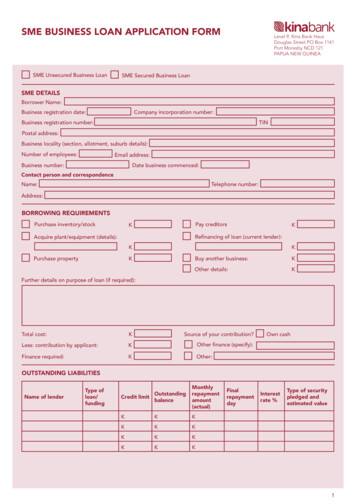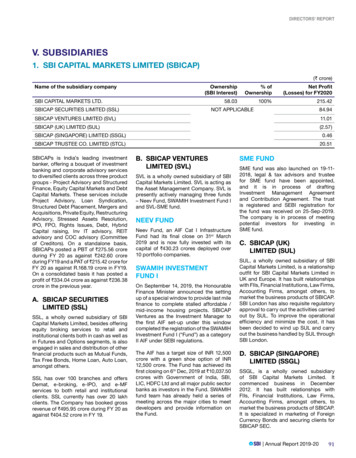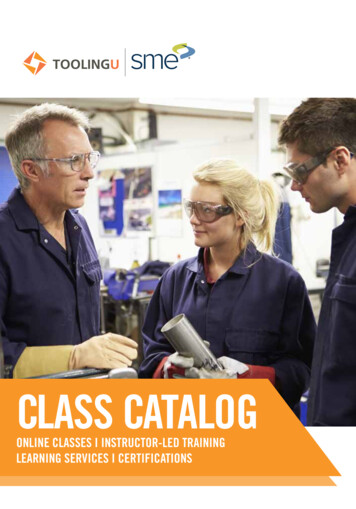
Transcription
CLASS CATALOGONLINE CLASSES I INSTRUCTOR-LED TRAININGLEARNING SERVICES I CERTIFICATIONS
WHY DO MORE THAN 50% OFFORTUNE 500 MANUFACTURINGCOMPANIES CHOOSE TOOLING U-SME?Here’s why: We provide competency-based learningsolutions focused on your performance outcomes.This catalog provides you with a detailed list of allour course offerings – online, instructor-led training,certification programs, books, and videos. But wedo so much more. We’ll analyze your needs, assessyour current knowledge, and develop a program thatfills the gaps. Then, we’ll help you launch, track,and measure the results.We are your training partner. With credentials.Over the last 80 years, we’ve worked with hundredsof thousands of individuals, over 5,000 companies,and over 550 educational institutions. Our coursesare aligned to national credentials including LeanCertification, Certified Manufacturing Engineer,and Certified Manufacturing Technologist,National Institute for Metalworking Skills (NIMS),Manufacturing Skills Standards Council (MSSC),American Welding Society (AWS), and SiemensMechatronics certifications. Our courses canalso be mapped to individual or state curriculumrequirements.TOOLING U-SME’S CUSTOMIZED TRAININGMAKES IT POSSIBLE TO: Develop mission critical skills Minimize the skills gap Expedite onboarding and define skills development Capture and standardize “tribal knowledge” nsure operational excellence/world classEmanufacturing Boost operational effectiveness and productivity Drive continuous improvement Improve quality and reduce scrap Leverage new technologies and drive innovation Cross train and increase workforce flexibility Reduce learning curve for new technologies Reduce risk and exposure Improve safety Drive complianceHow can we help you? Find out how we can partnerwith you to develop a competency-based solution tofit your training needs and your budget. Contact us atinfo@toolingu.com or 866.706.8665.1 TOOLINGU.COM I 866.706.8665
COMPETENCIESNINE OUT OF TEN MANUFACTURERSARE STRUGGLING TO FIND THE SKILLEDWORKERS THEY NEEDTo address this pressing challenge,Tooling U-SME brought together a cross-sectionof manufacturing experts to create a newindustry resource: a Competency Framework forachieving manufacturing excellence.The Competency Framework features acomprehensive series of competency models innine manufacturing functional areas. It is madeup of more than 60 job role competency models,which outline knowledge and skill objectivesfor production, technician, lead technician/technologist, and engineer-level job roles.Designed to complement other competencymodels in the industry, the CompetencyFramework can be used “as is” or customizedto individual work practices at your facility.Another benefit is that the knowledge objectiveswithin the framework are mapped directly toTooling U-SME’s extensive training resources.All this helps ensure your employees have theknowledge, skills, and abilities they need to behigh performers.The Competency Framework offersadvantages that tie directly to businessgoals. For example, our CompetencyFramework: nsures enterprise-wide consistency,Emaking a workforce more flexible anddynamic, and ultimately reducinglabor costs. treamlines the training process andScuts costs by eliminating unnecessaryand redundant training, allowing moretraining where needed. elps managers easily evaluate workerHperformance levels defined usingspecific behavioral indicators, whichreduces subjective assessment andincreases assessment accuracy. nhances employee satisfaction basedEon the rationality of the system. xplains career pathways and definesEwhat an average performer needs tobecome a superior performer.Created by a cross-section of manufacturing experts, Tooling U-SME’sCompetency Framework is a comprehensive series of competencymodels in nine manufacturing functional areas.2
TABLE OF CONTENTSFUNCTIONAL AREAHIGHLIGHTSPAGESafetyIntro to OSHA, fire safety and prevention, personal protective equipment,lockout/tagout procedures5Applied MathematicsFundamentals, fractions and decimals, units of measurements, basics oftolerance, blueprint reading5MaterialsIntro to materials, structure of metals, overview of plastic materials,mechanical properties of metals5InspectionBasic measurement, linear instrument characteristics, basics of the CMM,surface measurement, GD&T6Quality/LeanQuality overview, ISO 9000 overview, approaches to maintenance, leanmanufacturing overview7AbrasivesIntro to abrasives, what is grinding?, grinding processes, grinding variables,grinding wheel materials8CNCHistory and definition of CNC, mechanics of CNC, CNC coordinates, partprogram, CAD/CAM overview8CNC Controls: FanucControl panel overview, entering offsets, locating program zero, programexecution, program storage8CNC Controls: HaasControl panel overview, entering offsets, locating program zero, programexecution, program storage8CNC Controls: MazakControl panel overview, entering offsets, locating program zero, programexecution, program storage8Manual MachiningBasics of the manual mill, basics of the engine lathe, manual mill operation,holemaking on the mill9Metal CuttingMetal removal processes, safety for metal cutting, what is cutting?,machines for metal cutting9WorkholdingIntro to workholding, locating devices, clamping basics, fixture bodyconstruction, drill bushing selection9Electrical SystemsElectrical units, safety for electric work, intro to circuits, intro to magnetism,DC circuit components10Hydraulics &PneumaticsIntro to fluid systems, the forces of fluid power, intro to fluid conductors,fittings for fluid systems10Mechanical SystemsIntro to mechanical systems, safety of mechanical work, forces ofmachines, lubricant fundamentals10RiggingIntro to machine rigging, rigging equipment, lifting and moving equipment,rigging mechanics10Motor ControlsIntro to electric motors, logic and line diagrams, DC motor applications,solenoids, AC motor applications10PLCs: Allen Bradley/RockwellIntro to PLCs, basics of ladder logic, numbering systems and codes, basicprogramming11PLCs : SiemensNumbers, codes and data types for Siemens PLCs, Siemens PLCcommunication, Siemens SIMATIC modular PLCs, Siemens PLCProgramming Concepts11FoundationalMachiningMaintenance3 TOOLINGU.COM I 866.706.8665
FUNCTIONAL AREAHIGHLIGHTSPAGEMaintenance (continued)RoboticsIntro to robotics, robot safety, robot components, end effectors, robot axes,robot sensors11Oxyfuel, SMAW, GMAW, FCAW, Plasma, welding safety, weld types, weldinspection, submerged arc welding12Intro to additive manufacturing, additive manufacturing safety, additivemanufacturing methods and materials13WeldingWeldingAdditive /FabricatingStampingPress basics, stamping safety, punch and die operations, die components,die cutting variables13Press BrakePress brake safety, press brake components, bending fundamentals, diebending operations13Intro to composites, safety for composites processing, overview ofcomposite processes, materials for composites14Composites ProcessingCompositesAssembly/Final Stage ProcessesAdhesivesIntro to adhesive bonding, basics of the bonding process, types ofadhesives, surface preparation14CoatingsIntro to coating composition, surface preparation, processes for applyingcoatings, coating defects14FastenersIntro to assembly, safety for assembly, overview of threaded fasteners,torque fastener ergonomics14SolderingWhat is soldering?, safety for soldering, soldering equipment, solderingapplications14Concurrent engineering, DFM/DFA, precision machine design15LeadershipEssentials of leadership, global supply chain management, strategic projectmanagement, managing performance15Knowledge Edge Online collection of technical papers, videos, and books16Learning ServicesWorkforce performance assessments, custom program design, consulting17CustomizationCustom online courses, videos, white papers, instructor-led classes18CertificationsLean Bronze/Silver/Gold and CMfgT/CMfgE19AssessmentsEstablish baseline knowledge, identify skills gaps20NotesPlan the future of your training and development program21-22Design & EngineeringDesign & EngineeringLeadership4
FOUNDATIONALSafetyMaterialsIntroduction to OSHA 101 nErgonomics 102 nPersonal Protective Equipment 111 nNoise Reduction and Hearing Conservation 121 nRespiratory Safety 131 nLockout/Tagout Procedures 141 nMachine Guarding 140SDS and Hazard Communication 151 nBloodborne Pathogens 161 nWalking and Working Surfaces 171 nFire Safety and Prevention 181 nFlammable/Combustible Liquids 191 nHand and Power Tool Safety 201 nSafety for Lifting Devices 211 nPowered Industrial Truck Safety 221 nConfined Spaces 231 nEnvironmental Safety Hazards 241 nIntroduction to Physical Properties 101 nIntroduction to Mechanical Properties 111 nIntroduction to Metals 121 nIntroduction to Plastics 131 nMetal Manufacturing 140 nOverview of Plastic Processes 145Classification of Steel 201 nEssentials of Heat Treatment of Steel 211 nHardness Testing 221 nFerrous Metals 231 nNonferrous Metals 241 nThermoplastics 251 nThermosets 261 nCeramics 250Principles of Injection Molding 255Principles of Thermoforming 265Exotic Alloys 301 nApplied Mathematics (formerly Shop Essentials)Math Fundamentals 101 nMath: Fractions and Decimals 111 nApplied and Engineering Sciences 110Units of Measurement 112 nBasics of Tolerance 121 nManufacturing Process Applications: Part I 124Manufacturing Process Applications: Part II 125Blueprint Reading 131 nAlgebra Fundamentals 141 nGeometry: Lines and Angles 151 nGeometry: Triangles 161 nGeometry: Circles and Polygons 171 nShop Geometry Overview 170 nTrigonometry: The Pythagorean Theorem 201 nTrigonometry: Sine, Cosine, Tangent 211 nTrigonometry: Sine Bar Applications 221 nShop Trig Overview 210 nStatistics 231 nInterpreting Blueprints 230 nConcepts of Calculus 310 nPrint Reading n5 TOOLINGU.COM I 866.706.8665n CLASS 2.0n AVAILABLE IN SIMPLIFIED CHINESEn INSTRUCTOR-LED TRAININGAll classes available in Spanish except CLASS 2.0 coursesAll classes ONLINE except where noted
InspectionBasic Measurement 101 nCalibration Fundamentals 111 nBasics of Tolerance 121 nBlueprint Reading 131 nHole Standards and Inspection 141 nThread Standards and Inspection 151 nSurface Texture and Inspection 201 nMeasuring System Analysis 300Introduction to GD&T 301 nIntroduction to GD&T 200 (1994)Major Rules of GD&T 311 nInterpreting GD&T 310 (1994)Inspecting a Prismatic Part 321 nInspecting a Cylindrical Part 331 nAdvanced Hole Inspection 341 nInspecting with Optical Comparators 351 nInspecting with CMMs 361 nCalibration and Documentation 371 nIn-Line Inspection Applications 381 nGD&T nGD&T Overview nGD&T for DFM n6
FOUNDATIONAL(Continued)Quality/LeanQuality Overview 100 nLean Manufacturing Overview 101 nISO 9000 Review 121 nISO 9001 2015 Review 122 nContinuous Process Improvement: Managing Flow 124Continuous Process Improvement: Identifying andEliminating Waste 125Approaches to Maintenance 131 nProcess Design and Development 133Product Design and Development 134Developing a Lean Culture 135Production System Design and Development 136Equipment/Tool Design and Development 137Introduction to Supply Chain Management 140Total Productive Maintenance 141 n5S Overview 151 nCell Design and Pull Systems 161 nIntroduction to Six Sigma 171 nQuality and Customer Service 175Troubleshooting 181 nConducting Kaizen Events 191 nConducting an Internal Audit 201 nSPC Overview 211 nTS 16949: 2009 Overview 221 nMetrics for Lean 231 nProcess Flow Charting 241 nStrategies for Setup Reduction 251 nTotal Quality Management Overview 261 nManagement Tools: Problem Solving 270Management Tools: Product and Process Design 275Value Stream Mapping: The Present State 301 nValue Stream Mapping: The Future State 311 nSix Sigma Goals and Tools 310Managing Practices for Total Quality 320Maintaining a Consistent Lean Culture 330Transforming Lean into Business Results 3407 TOOLINGU.COM I 866.706.8665Measuring Lean Systems 350Introduction to Lean: Overview of the Lean Toolbox nUnderstanding the Tools and Best Practices ofLean Manufacturing nFundamentals: Firm Grasp on Waste andGetting 5S Right nThe Human Side of Lean nIntegrating Green Manufacturing and Lean nKanban: Inventory and Demand Management nPlanning Manufacturing Cells nRole of TPM in the Lean Enterprise nPlanning and Executing Kaizen nKaizen Workshop nSMED: Setup/Changeover Reduction nDocumenting and Developing Process Flow nValue Stream Mapping: Diagram the Information andMaterial Flows in Your Business nSix Sigma Green Belt nSix Sigma Yellow Belt nAPQP/FMEA/Control Plans/Error Proofing nAdvanced Product Quality Planning (APQP) nDesign of Experiments (DOE) nFailure Mode and Effects Analysis (FMEA)Fundamentals nStatistical Process Control (SPC) Fundamentals nValue Analysis and Value Engineering (VA/VE) nSample of Knowledge Edge contentWhat Lean Means (video)Kaizen Event Fieldbook (eBook)Mapping Your Value Stream (video)Strategic Project Management (eBook)Managing Teams in Manufacturing (video)AssessmentsManufacturing Survey
MACHININGAbrasivesIntroduction to Abrasives 100What Is Grinding? 110 nGrinding Processes 201 nGrinding Safety 211 nBasic Grinding Theory 221 nDressing and Truing 230 nBasics of the Surface Grinder 231 nBasics of the Cylindrical Grinder 232 nBasics of the Centerless Grinder 233 nSetup for the Surface Grinder 241 nSetup for the Cylindrical Grinder 242 nSurface Grinder Operation 251 nCylindrical Grinder Operation 252 nCenterless Grinder Operation 260Setup for Centerless Grinders 320Grinding Ferrous Materials 311 nGrinding Nonferrous Materials 321 nGrinding Wheel Materials 331 nGrinding Wheel Geometry 361 nPrecision Grinding & Abrasive MachiningCertificate Program nModern Grinding Technology nCNCHistory and Definition of CNC 100 nIntroduction to CNC Machines 201 nBasics of the CNC Lathe 211 nBasics of the CNC Mill 212 nBasics of the CNC Swiss-Type Lathe 135 nCoordinates for the CNC Lathe 221 nCoordinates for the CNC Mill 222 nBasics of G Code Programming 231 nIntroduction to CAD and CAM for Machining 241 nControl Panel Functions for the CNC Lathe 251 nControl Panel Functions for the CNC Mill 252 nOffsets on the CNC Mill 262 nCNC Offsets 210 nCNC Specs for the Mill 220 nCNC Specs for the Lathe 225 nCreating a CNC Turning Program 301 nTurning Calculations 285 nCreating a CNC Milling Program 302 nMilling Calculations 295Canned Cycles for the Lathe 321 nCanned Cycles for the Mill 322 nComputer Numerical Control (CNC) nCNC Controls: FanucFanuc Mill: Control Panel Overview 250Fanuc Lathe: Control Panel Overview 255Fanuc Mill: Entering Offsets 260Fanuc Lathe: Entering Offsets 265Fanuc Mill: Locating Program Zero 270Fanuc Lathe: Locating Program Zero 275Fanuc Mill: Program Execution 280Fanuc Lathe: Program Execution 285Fanuc Mill: Program Storage 310Fanuc Lathe: Program Storage 315Fanuc Mill: First Part Runs 320Fanuc Lathe: First Part Runs 325CNC Controls: HaasHaas Mill: Control Panel Overview 250Haas Lathe: Control Panel Overview 255Haas Mill: Entering Offsets 260Haas Lathe: Entering Offsets 265Haas Mill: Locating Program Zero 270Haas Lathe: Locating Program Zero 275Haas Mill: Program Execution 280Haas Lathe: Program Execution 285Haas Mill: Program Storage 310Haas Lathe: Program Storage 315Haas Mill: First Part Runs 320Haas Lathe: First Part Runs 325CNC Controls: MazakMazak Mill: Control Panel Overview 250Mazak Lathe: Control Panel Overview 255Mazak Mill: Safety for the Mill 260Mazak Lathe: Safety for the Lathe 265Mazak Mill: Locating Program Zero 270Mazak Lathe: Locating Program Zero 275Mazak Mill: Entering Offsets 280Mazak Lathe: Entering Offsets 285Creating an EIA/ISO Program for theMazak Mill 286Creating an EIA/ISO Program for theMazak Lathe 287Creating a Mazatrol Program for the Mill 288Creating a Mazatrol Program for the Lathe 289n CLASS 2.0n AVAILABLE IN SIMPLIFIED CHINESEn INSTRUCTOR-LED TRAININGAll classes available in Spanish except CLASS 2.0 coursesAll classes ONLINE except where noted8
MACHINING(Continued)Mazak Mill: Program Execution 290Mazak Lathe: Program Execution 295Mazak Mill: Program Storage 310Mazak Lathe: Program Storage 315Mazak Mill: First Part Runs 320Mazak Lathe: First Part Runs 325Manual MachiningBasics of the Manual Mill 110Basics of the Engine Lathe 115 nOverview of Manual Mill Setup 200Overview of Engine Lathe Setup 205Benchwork and Layout Operations 210Manual Mill Operation 220Engine Lathe Operation 225 nHolemaking on the Mill 230Threading on the Engine Lathe 235Taper Turning on the Engine Lathe 240Metal CuttingSafety for Metal Cutting 101 nCutting Processes 111 nOverview of Machine Tools 121 nBasic Cutting Theory 201 nIntroduction to Screw Machining 160Band Saw Operation 211 nIntroduction to Metal Cutting Fluids 221 nMetal Cutting Fluid Safety 231 nToolholders for Turning 260Speed and Feed for the Lathe 301 nSpeed and Feed for the Mill 311 nCutting Tool Materials 321 nCarbide Grade Selection 331ANSI Insert Selections 341 nLathe Tool Geometry 351 nMill Tool Geometry 361 nDrill Tool Geometry 371 nOptimizing Tool Life and Process 381 nn AVAILABLE IN SIMPLIFIED CHINESEn INSTRUCTOR-LED TRAININGAll classes available in Spanish except CLASS 2.0 coursesAll classes ONLINE except where noted9 TOOLINGU.COM I 866.706.8665Impact of Workpiece Materials 391 nHigh-Speed Machining 310Hard Turning 315Machining Titanium Alloys 325Introduction to EDM 100High-Speed, High-Power Machining nMachining Process Optimization Program nHigh-Speed Endmilling for Die, Mold, Aerospace,Racing, and Prototype Shops nMetalworking Fluid ManagementCertificate Program nWorkholdingIntroduction to Workholding 104 nSupporting and Locating Principles 106 nLocating Devices 107 nClamping Basics 108 nChucks, Collets, and Vises 110 nFixture Body Construction 200Fixture Design Basics 210Drill Bushing Selection 230Sample of Knowledge Edge contentHigh-Speed Machining (eBook)Cutting Tool Geometries (video)Milling and Machining Centers (video)Parametric Programming for Computer NumericalControl Machine Tools and Touch Probes (eBook)Precision Machine Design (eBook)AssessmentsCNC Operator: LatheCNC Operator: MillCNC ProgrammerMachinist/Machine SetterMachinist: Tool RoomProduction Grinder
MAINTENANCEElectrical SystemsMechanical SystemsElectrical Units 101 nSafety for Electric Work 111Introduction to Circuits 201 nIntroduction to Magnetism 211 nDC Circuit Components 221 nNEC Overview 231AC Fundamentals 241Electrical Instruments 251Electrical Print Reading 261 nDC Power Sources 271AC Power Sources 281Conductor Selection 240Series Circuit Calculations 301 nParallel Circuit Calculations 311 nBattery Selection 321Industrial Electrical Fundamentals nAC Motor Controls and Relay Ladder Logic nVariable Frequency Drives nTroubleshooting Electrical Systemswith Schematics nIntroduction to Mechanical Systems 100Safety for Mechanical Work 111 nForces of Machines 110Power Transmission Components 120Lubricant Fundamentals 130Mechanical Power Variables 200Bearing Applications 221 nSpring Applications 220Belt Drive Applications 221Gear Geometry 240Gear Applications 245Clutch and Brake Applications 250Mechanical Fundamentals nIntroduction to Lubrication nHydraulics & PneumaticsIntroduction to Fluid Systems 100Safety for Hydraulics and Pneumatics 105The Forces of Fluid Power 110Introduction to Hydraulic Components 120Introduction to Pneumatic Components 231 nIntroduction to Fluid Conductors 241 nFittings for Fluid Systems 135Preventive Maintenance for Fluid Systems 140Hydraulic Power Variables 200Pneumatic Power Variables 205Hydraulic Power Sources 210Pneumatic Power Sources 215Fluid System Print Reading 220Hydraulic Control Valves 230Pneumatic Control Valves 235Actuator Applications 240Basic Hydraulic Circuit Design 310Basic Pneumatic Circuit Design 315Hydraulic Fluid Selection 320Contamination and Filter Selection 330Hydraulic Principles and System Design 340Level 1 Industrial Hydraulics nHydraulic Connectors and Conductors nLevel 2 Industrial Hydraulics nHydraulic Troubleshooting Using Schematics nLevel 1 Pneumatics nRiggingIntroduction to Machine Rigging 110Rigging Equipment 120Lifting and Moving Equipment 130Rigging Inspection and Safety 210Rigging Mechanics 220Motor ControlsIntroduction to Electric Motors 301 nSymbols and Diagrams for Motors 210Logic and Line Diagrams 220DC Motor Applications 230Solenoids 235AC Motor Applications 240Relays, Contractors, and Motor Starters 201 nControl Devices 260Reversing Motor Circuits 310Distribution Systems 320Specs for Servomotors 330Timers and Counters 340Electronic Semiconductor Devices 350Photonic Semiconductor Devices 355Limit Switches and Proximity Sensors 360Photoelectric and Ultrasonic Devices 365Reduced Voltage Starting 370Solid-State Relays and Starters 375Deceleration Methods 380Acceleration Methods 38510
MAINTENANCE(Continued)PLCs: Allen Bradley/RockwellIntroduction to PLCs 200Hardware for PLCs 210Basics of Ladder Logic 220Numbering Systems and Codes 230PLC Inputs and Outputs 240Basic Programming 250PLC Timers and Counters 260Networking for PLCs 270Hand-Held Programmers of PLCs 280PLC Diagrams and Programs 300Overview of PLC Registers 305PLC Program Control Instructions 310Math for PLCs 320Sequencer Instructions for PLCs 330PLC Installation Practices 340PID for PLCs 350Data Manipulation 360Shift Registers 370Level 1 PLC Fundamentals nPLCs: SiemensBasics of Siemens PLCs 200Siemens PLC Hardware 210Numbers, Codes, and Data Types forSiemens PLCs 220Siemens PLC Communication 230Siemens PLC Inputs and Outputs 240Siemens Human Machine Interfaces 250Siemens SIMATIC Modular PLCs 260Siemens PLC Programming Concepts 270Basic Ladder Diagram Programming forSiemens PLCs 280Basic Function Block Diagram Programmingfor Siemens PLCs 290Ladder Diagram Timers and Counters forSiemens PLCs 300Function Block Diagram Timers and Countersfor Siemens PLCs 310Additional Ladder Diagram Instructions forSiemens PLCs 32011 TOOLINGU.COM I 866.706.8665Additional Function Block Diagram Instructionsfor Siemens PLCs 330Siemens SIMATIC S7-1200 PLCs 340Siemens SIMATIC S7-1500 PLCs 350Siemens Safety Integrated forFactory Automation 360RoboticsIntroduction to Robotics 110Robot Safety 211 nRobot Components 120End Effectors 125Applications for Robots 130Automated Systems and Control 135Robot Axes 140Robot Sensors 150Robot Troubleshooting 160Robot Maintenance 170Concepts of Robot Programming 210Robotic Drives, Hardware, and Components 220Robot Installations 230Robotic Control Systems 240Vision Systems 250Industrial Network Integration 260Sample of Knowledge Edge contentDie Maintenance Handbook (eBook)TPM: Total Productive MaintenanceIndustrial Robotics (video)Autonomous Activities (video)Die Maintenance Handbook (eBook)AssessmentsElectrician: IndustrialInspector: MechanicalMaintenance and Repair: GeneralMaintenance and Repair: Industrial Machinery
WELDINGWeldingSample of Knowledge Edge contentWhat Is Oxyfuel Welding? 100Oxyfuel Welding Safety 105Welding Safety Essentials 101 nPPE for Welding 111 nWelding Fumes and Gases Safety 121 nElectrical Safety for Welding 131 nIntroduction to Welding 141 nWhat Is Arc Welding? 110Introduction to Welding Processes 151 nArc Welding Processes 120 nMath Fundamentals for Welding 161 nGeometry Fundamentals for Welding 171 nMaterial Tests for Welding 201 nWelding Ferrous Metals 211 nWelding Nonferrous Metals 212 nOverview of Weld Types 221 nOverview of Weld Defects 222 nArc Welding Symbols and Codes 231 nFabrication Process 232 nElectrical Power for Arc Welding 241 nIntroduction to GMAW 251 nIntroduction to SMAW 252 nIntroduction to FCAW 261 nIntroduction to GTAW 262 nIntroduction to Submerged Arc Welding 160Arc Welding Power Sources 260Electrode Selection 270Overview of Soldering 271 nThermal Cutting Overview 281 nOxyfuel Cutting Applications 282 nPlasma Cutting 283 nIntroduction to Automation 291 nGMAW Applications 301 nAdvanced GMAW Applications 302 nSMAW Applications 311 nFCAW Applications 321 nGTAW Applications 331 nOxyfuel Welding Applications 207SAW Applications 255Arc Welding Aluminum Alloys 310Chapter 13: Welding Process (eChapter)Advanced Robotic WeldingChapter 26: Welding/Joining (eChapter)Chapter 10: Estimating Welding Costs (eChapter)Welding IntroductionAssessmentsArc Weldern AVAILABLE IN SIMPLIFIED CHINESEAll classes available in Spanish except CLASS 2.0 coursesAll classes ONLINE except where noted12
ADDITIVE MANUFACTURINGAdditive ManufacturingSample of Knowledge Edge contentIntroduction to Additive Manufacturing 110Additive Manufacturing Safety 120The Basic Additive Manufacturing Process 130Additive Manufacturing Methods and Materials 140Design for Additive Manufacturing 201 nAdditive Manufacturing Materials Science 211 nIntegrating Additive Manufacturingwith Traditional Manufacturing 221 nAdditive Manufacturing as a Secondary Process 231 nAdditive Manufacturing Overview nAdvanced Additive Manufacturing Materials (tech paper)Metal Powders for Additive ManufacturingRapid Prototyping (video)Medical Applications of Rapid Prototyping (video)Advances and New Technologies in AdditiveManufacturing of metals (tech paper)STAMPING/FORMING/FABRICATINGStampingPress Basics 110Stamping Safety 115Punch and Die Operations 120Die Components 130Coil Handling Equipment 140Die Cutting Variables 200Monitoring Press Operations 220Guiding System Components 230Stripper System Components 235Coil Loading Procedures 250Die Setting Procedures 300Coil Slitting Fundamentals nCoil Slitting & Leveling Certificate Program nLaser Cutting Certificate Program nMetal Formability Certificate Program nMetal Stamping Press MaintenanceCertificate Program nStamping Die Certificate Program nDie Bending Operations 130Operating the Press Brake 200Press Brake Specifications 220Sample of Knowledge Edge contentPress Brake Technology (eBook)Punch Presses (video)Quick Die Change (eBook)Laser Cutting Guide for Manufacturing(eBook)New Technologies in Forming and Fabricating(tech paper)AssessmentsPress Brake OperatorPress OperatorPress BrakePress Brake Safety 100Press Brake Components 110Bending Fundamentals 120n INSTRUCTOR-LED TRAININGAll classes available in Spanish except CLASS 2.0 coursesAll classes ONLINE except where noted13 TOOLINGU.COM I 866.706.8665
COMPOSITES PROCESSINGCompositesIntroduction to Composites 110Safety for Composite Processing 115Overview of Composite Processes 120Traditional Composites 125Advanced Thermoset Resins for Composites 130Advanced Materials for Composites 135Introduction to Lay-up and Spray-up Molding 140Introduction to Compression Molding 170Surface Finishing Composites 190Vacuum Bagging Technique:Single-Sided Bagging 230Composite Inspection and Defect Prevention 240Repair Methods for Composites 250Introduction to Composites nJoining and Bonding Composite Structures nMetallurgy Certificate Program nRepair of Advanced Composite Structures nTooling for Composites nSample of Knowledge Edge contentIntroduction to Composites Technology (eBook)Automated Composite Layup and Spray Up (video)Filament Winding (video)Successful Composites Technology Transfer: ApplyingNASA Innovations to Industry (eBook)Composites Post Fabrication and Joining (video)ASSEMBLY/FINAL STAGE PROCESSESAdhesivesSolderingIntroduction to Adhesive Bonding 110Basics of the Bonding Process 120Introduction to Adhesive Properties 130Types of Adhesives 140Surface Preparation 210Steps for Adhesive Application 220What is Soldering? 110Safety for Soldering 115Soldering Equipment 130Soldering Applications 200Solder and Flux Selection 210Soldering PCBs 220Lead-Free Soldering 230CoatingsIntroduction to Coating Composition 110Surface Preparation for Coatings 120Processes for Applying Coatings 140Coating Defects 150Troubleshooting Coating Defects 170FastenersIntroduction to Assembly 100Safety for Assembly 105Introduction to Fastener Threads 110Overview of Threaded Fasteners 117Tools for Threaded Fasteners 120Overview of Non-Threaded Fasteners 125Introduction to Fastener Ergonomics 130Properties for Fasteners 200Understanding Torque 210Threaded Fastener Selection 215Sample of Knowledge Edge contentSuccessful Assembly Automation (eBook)Plastics Machining and Assembly (video)Fastening and Assembly (video)Brazing and Soldering (video)Design for Manufacture and Assembly(DFMA) (video)AssessmentsAssembler ProgramAssembler: Electrical14
DESIGN & ENGINEERINGDesign & EngineeringSample of Knowledge Edge contentConcurrent Engineering nDesign for Manufacturability and Assembly(DFM/DFA) nGD&T for DFM nMeasurement Inspection and Gaging Level 1 nMeasurement Inspection and Gaging Level 2 nPrecision Machine Design nPractical Applications of Machine Tool Metrology nLean Product Development nTolerance Stack-Up Analysis nLean Product Development (video)Measurement and Gaging (video)Gaging and Inspection Tool Design (video)Design for Manufacture and Assembly(DFMA) (video)DFM: Design for Manufacturing (video)AssessmentsProduction/Manufacturing EngineerSales EngineerLEADERSHIPLeadershipSample of Knowledge Edge contentEssentials of Leadership 110Essentials of Communication 120Managing Performance: Best Practices 130Managing Performance: Corrective Actions 135Basics of Manufacturing Costs 140Introduction to Managerial Accounting 145Conflict Resolution Principles 150Conflict Resolution for Different Groups 155Team Leadership 160Manufacturing Management 180Personal Effectiveness 190Managing the Diverse Workplace 210Harassment and Discrimination 215Performance Management and the Law 230Computerized Maintenance Management System(CMMS) Certificate Program nCycle Time Management/Reengineering nGlobal Supply Chain Management nHow to Coach Your People toThink Independently nIndustrial Engineering Fundamentals nManufacturing Technology Fundamentals nStrategic Project Management nProject Risk Management nRapid and Accurate Cost Estimating and Quoting nWalking the Talk Certificate Series nStrategic Project Management (eBoo
Certification, Certified Manufacturing Engineer, and Certified Manufacturing Technologist, National Institute for Metalworking Skills (NIMS), Manufacturing Skills Standards Council (MSSC), American Welding Society (AWS), and Siemens Mechatronics certifications. Our courses can requirements. How can we help you? Find out how we can partner
